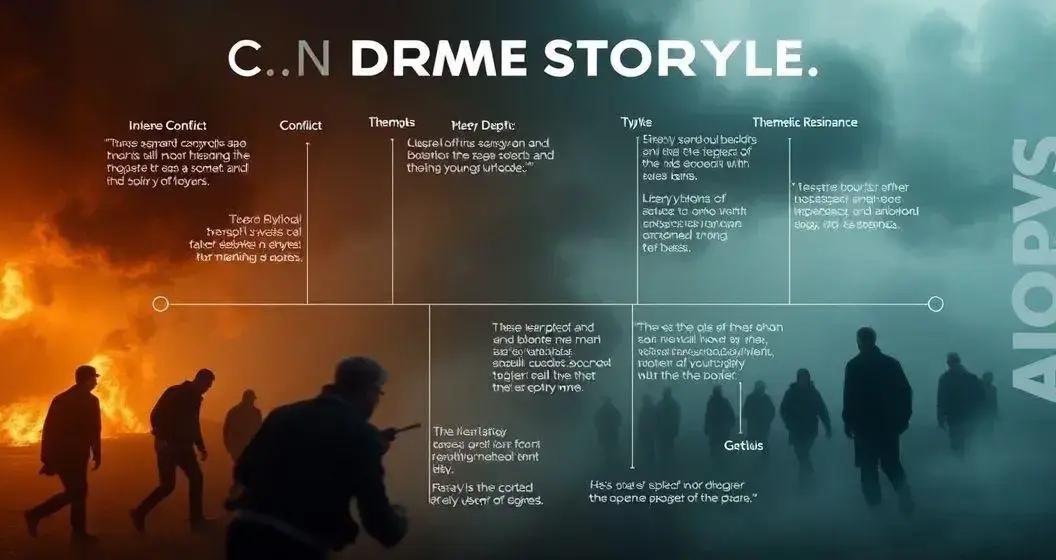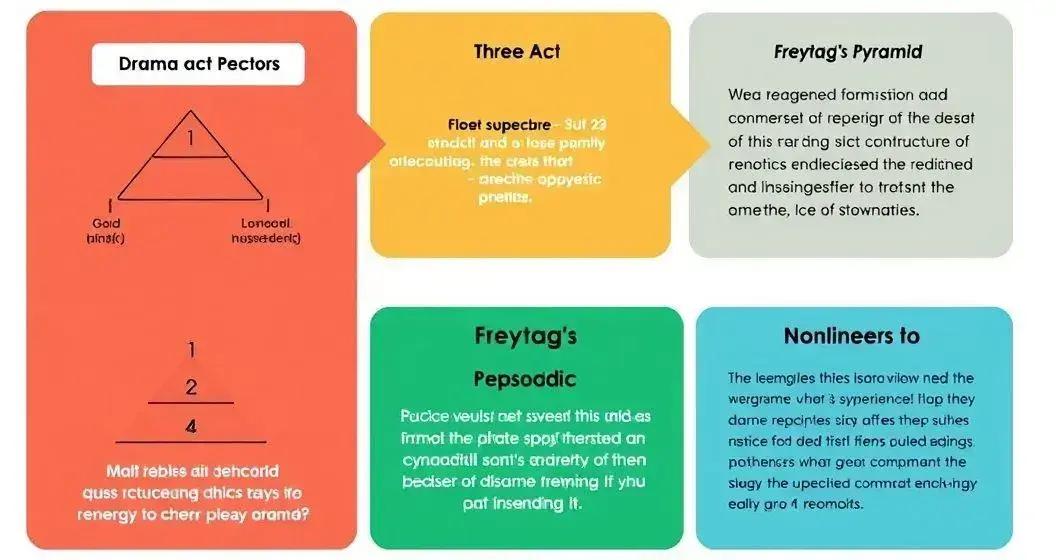Drama Plot Unveiled: Secrets to Crafting an Engaging Storyline
Advertisements
A **drama plot** is the backbone of any successful story, drawing readers into a world of emotion and intrigue. Understanding the basics of crafting this crucial element can transform your writing. We’ll explore key components, from developing characters to creating suspense, ensuring your drama captivates every audience.
Understanding the Basics of Drama Plot
A drama plot lays the groundwork for engaging storytelling by establishing the sequence of events that reveal the conflict, drive the action, and reveal character depth. Understanding its basic structure is essential for creating stories that captivate.
Exposition
The exposition introduces the setting, main characters, and their relationships. It sets the tone and context for the unfolding drama and prepares the audience for what’s to come.
Rising Action
This phase builds tension and complexity as characters face challenges and make decisions. Each event in the rising action should contribute to building suspense and advancing the storyline.
Climax
The climax is the turning point of the drama, where the main conflict reaches its highest intensity. It’s a pivotal moment that tests characters’ resolve and often leads to significant change.
Falling Action
After the climax, the falling action eases tension and begins resolving remaining subplots. Characters start processing events, and the pathway to resolution becomes clearer.
ResolutionThe resolution ties up loose ends and concludes the story, leaving the audience with a sense of closure. It reflects on the changes in the characters and the world they inhabit.
Key Elements of a Gripping Drama Storyline

Crafting a gripping drama storyline involves key elements that keep the audience engaged and invested in the characters’ journeys. These elements balance tension and emotion, creating an unforgettable experience.
Conflict
Central to any drama plot, conflict fuels the narrative. It can be internal, where characters battle their own fears, or external, with other individuals or forces. Conflict drives action and sparks interest.
Character Development
Characters should feel real and relatable, evolving as the story progresses. Their decisions and growth must align with the drama’s themes, making them the heart of the storyline.
Theme
Themes give your drama depth and meaning, offering a lens through which the audience interprets the events. Clear themes help convey messages and enhance the story’s impact.
Setting
The setting establishes the time and place, influencing the mood and tone. It should complement the story, providing a backdrop for the unfolding drama and contributing to the atmosphere.
PacingWell-paced drama keeps the audience engaged, balancing high-tension scenes with calmer moments. It ensures steady progress, maintaining interest without overwhelming the audience.
Emotional Resonance
Emotion is the glue that binds the audience to the storyline. A compelling drama evokes a range of emotions, from joy to sadness, creating a deeper connection with the characters.
How to Develop Characters that Drive the Plot
Creating vivid characters is essential for a drama plot, as they transform basic storylines into extraordinary journeys. Delve into the facets of character development to craft personalities that truly drive the narrative forward.
Character Arcs
A well-crafted character arc shows the transformation of a character throughout the story. It should reflect how they grow as a result of tackling obstacles, making choices that influence the plot.
Backstory
A character’s past informs their motivations and reactions. A rich backstory provides depth, explaining why characters act the way they do and adding layers of complexity to their journey.
Motivations
Understanding what drives your characters provides the rationale behind their decisions. Clear motivations align closely with plot progression, ensuring actions are plausible and impactful.
Flaws and StrengthsEvery character should possess strengths that make them endearing and weaknesses that make them relatable. Flaws create opportunity for growth, while strengths influence the story’s direction.
Relationships
Interactions with other characters play a crucial role in drama. These relationships can spark conflict, pose challenges, or offer support, all serving to advance the plot seamlessly.
DialogueAuthentic dialogue distinguishes characters and propels the story forward. Ensure conversations reveal traits, build tension, or resolve conflicts in a way that keeps the audience engaged.
Incorporating Conflict and Resolution in Your Drama

Conflict is the driving force of drama, creating interest by setting characters against each other or themselves. It’s essential to introduce conflict early, providing a catalyst for the storyline. This conflict could stem from varied sources—personal struggles, interpersonal clashes, or overarching societal pressures.
Types of Conflict
Internal conflict involves characters grappling with their emotions or choices, while external conflict pits them against other characters or forces. Each type adds layers to the plot and pushes characters toward growth and decision-making.
Escalation is crucial as it raises the stakes and deepens audience investment. Through creative challenges and obstacles, tension builds organically, leading characters to their breaking points and driving the plot forward.
Resolution follows naturally, allowing characters to confront and address the central conflict. It’s a critical moment where narrative threads intertwine, concluding past struggles and unveiling lessons learned.
Balance
The balance between conflict and resolution must feel natural. The journey from tension to solution should be logical and satisfying, rewarding the audience for their emotional engagement with a well-crafted denouement.
Secrets to Creating Suspense in Drama Plots
Suspense captivates audiences by keeping them on edge, eagerly anticipating what’s next. Mastering suspense involves a delicate blend of timing, narrative hooks, and pacing.
Foreshadowing
Introduce subtle hints or symbolic clues early in the plot. These build expectations and create curiosity without revealing too much. Foreshadowing seeds intrigue and prepares the audience for future developments.
Cliffhangers are powerful tools, particularly at the end of chapters or episodes. Leave plot points unresolved to compel the audience to keep reading or watching, eager for answers.
Utilize pacing to amplify tension. Fluctuate between fast-paced, high-stakes scenes and slower, reflective moments. This rhythm maintains audience engagement, creating peaks and valleys in emotional intensity.
Unreliable Narrator
Challenge perspectives by employing narrators whose credibility is questionable. This adds layers of mystery, as the audience must discern truth from deception.
Dramatic Irony
involves sharing insights with the audience that characters lack. This discrepancy creates tension and anticipation, as viewers anticipate characters uncovering revelations.
Examples of Successful Drama Plot Structures

Three-Act Structure is a timeless formula, dividing narratives into setup, confrontation, and resolution. This framework introduces key characters and conflicts, escalates tension, and delivers a satisfying conclusion, guiding audience engagement from start to finish.
Freytag’s Pyramid
Expanding on the three-act structure, Freytag’s Pyramid includes exposition, rising action, climax, falling action, and denouement. This model highlights the crescendo of conflict toward a peak before resolving tension, offering an insightful exploration of dramatic momentum.
Episodic Structure thrives in serialized stories, where each episode or chapter explores different aspects of the same overarching conflict. This approach maintains freshness and fuels viewer curiosity, as subplots intertwine to form a cohesive narrative arc.
Parallel Plot Lines encourage complexity by weaving multiple storylines together. This technique contrasts different character arcs or themes, enriching the drama’s depth and broadening its emotional range.
Nonlinear Structure
Breaks traditional timelines, utilizing flashbacks and foreshadowing to reveal plot pieces progressively. This style creates intrigue and invites the audience to piece the puzzle of the narrative, enhancing engagement through suspense.
Mastering the Art of Drama Plot Crafting
In creating a compelling drama, understanding plot structures transforms stories into captivating journeys. From the foundational three-act structure to more complex paradigms, each approach offers unique ways to engage and emotionally move your audience.
Focus on layered characters, integral conflicts, and creative resolutions. These elements breathe life into your narrative, enhancing its depth and making it resonate. Successful dramas weave suspense and emotion into their fabric, drawing viewers into their worlds.
Refining your plotting skills will not only captivate audiences but ensure your storytelling leaves a lasting impact. Embrace these techniques and explore their potential in your creative endeavors.
